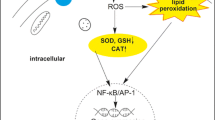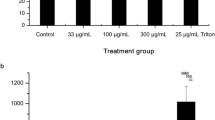Abstract
In the present work, the effects of aliphatic (n-nonane and n-decane), alicyclic (1,2,4-trimethylcyclohexane and tert-butylcyclohexane, t-BCH) and aromatic (trimethylbenzene and tert-butylbenzene) hydrocarbon solvents on formation of reactive oxygen species (ROS) and the proinflammatory cytokine TNF-α in rat alveolar macrophages (AM) have been investigated. Formation of ROS was assessed by monitoring oxidation of 2′,7′-dichlorofluorescin to 2′,7′-dichlorofluorescein (DCF), and the proinflammatory cytokine tumour necrosis factor α (TNF-α) was detected using an enzyme-linked immunosorbent assay. DCF fluorescence was elevated in a concentration-dependent manner by the alicyclic hydrocarbons. The involvement of transcellular signalling pathways in the production of ROS by t-BCH, the most active compound, was elucidated by use of specific inhibitors. Preincubation of the AM with the mitogen-activated protein kinase (ERK 1/2) inhibitor U0126, the protein kinase C inhibitor bisindolylmaleimide, the superoxide dismutase inhibitor diethyldithiocarbamate, and the iron ion chelating agent deferoxamine reduced the DCF fluorescence significantly. t-BCH gave an increase in TNF-α release. Further, nitric oxide production measured by a modified Griess method, and intracellular calcium concentration measured by fura-2, were increased in the rat AM after exposure to t-BCH.






Similar content being viewed by others
References
Babior BM (1999) NADPH oxidase: an update. Blood 93:1464–1476
Bit RA, Davis PD, Elliott LH, Harris W, Hill CH, Keech E, Kumar H, Lawton G, Maw A, Nixon JS, Vesey DR, Wadsworth J, Wilkinson SE (1993) Inhibitors of protein kinase C. 3. Potent and highly selective bisindolylmaleimides by conformational restrictions. J Med Chem 36:21–29
Doelman CJ, Bast A (1990) Oxygen radicals in lung pathology. Free Radic Biol Med 9:381–400
Dreiem A, Myhre O, Fonnum F (2002) Relationship between Lipophilicity of C6–10 hydrocarbon solvents and their ROS-inducing potency in rat cerebellar granule cells. Neurotoxicology 103:1–9
Duncia JV, Santella JB, Higley CA, Pitts WJ, Wityak J, Frietze WE, Rankin FW, Sun JH, Earl RA, Tabaka AC, Teleha CA, Blom KF, Favata MF, Manos EJ, Daulerio AJ, Stradley DA, Horiuchi K, Copeland RA, Scherle PA, Trzaskos JM, Magolda RL, Trainor GL, Wexler RR, Hobbs FW, Olson RE (1998) MEK inhibitors: the chemistry and biological activity of U0126, its analogs, and cyclization products. Bioorg Med Chem Lett 8:2839–2844
Favata MF, Horiuchi KY, Manos EJ, Daulerio AJ, Stradley DA, Feeser WS, Van Dyk DE, Pitts WJ, Earl RA, Hobbs F, Copeland RA, Magolda RL, Scherle PA, Trzaskos JM (1998) Identification of a novel inhibitor of mitogen-activated protein kinase kinase. J Biol Chem 273:18623–18632
Fink MP (2002) Role of reactive oxygen and nitrogen species in acute respiratory distress syndrome. Curr Opin Crit Care 8:6–11
Foster JR (2001) The functions of cytokines and their uses in toxicology. Int J Exp Pathol 82:171–192
Gaston B, Drazen JM, Loscalzo J, Stamler JS (1994) The biology of nitrogen oxides in the airways. Am J Respir Crit Care Med 149:538–551
Grynkiewicz G, Poenie M, Tsien RY (1985) A new generation of Ca2+ indicators with greatly improved fluorescence properties. J Biol Chem 260:3440–3450
Guy GR, Chua SP, Wong NS, Ng SB, Tan YH (1991) Interleukin 1 and tumor necrosis factor activate common multiple protein kinases in human fibroblasts. J Biol Chem 266:14343–14352
Halliwell B, Gutteridge JM (1999) Free radicals in biology and medicine. Clarendon Press, Oxford
Hetland RB, Myhre O, Låg M, Hongve D, Schwarze PE, Refsnes M (2001) Importance of soluble metals and reactive oxygen species for cytokine release induced by mineral particles. Toxicology 165:133–144
Jacobson PB, Kuchera SL, Metz A, Schachtele C, Imre K, Schrier DJ (1995) Anti-inflammatory properties of Go 6850: a selective inhibitor of protein kinase C. J Pharmacol Exp Ther 275:995–1002
Kessels GC, Krause KH, Verhoeven AJ (1993) Protein kinase C activity is not involved in N-formylmethionyl-leucyl-phenylalanine-induced phospholipase D activation in human neutrophils, but is essential for concomitant NADPH oxidase activation: studies with a staurosporine analogue with improved selectivity for protein kinase C. Biochem J 292:781–785
Laskin DL, Pendino KJ (1995) Macrophages and inflammatory mediators in tissue injury. Annu Rev Pharmacol Toxicol 35:655–677
Maher JJ (1999) Cytokines: overview. Semin Liver Dis 18:109–115
Miranda KM, Espey MG, Wink DA (2001) A rapid, simple spectrophotometric method for simultaneous detection of nitrate and nitrite. Nitric Oxide 5:62–71
Moncada S, Palmer RM, Higgs EA (1991) Nitric oxide: physiology, pathophysiology, and pharmacology. Pharmacol Rev 43:109–142
Morel F, Doussiere J, Vignais PV (1991) The superoxide-generating oxidase of phagocytic cells. Physiological, molecular and pathological aspects. Eur J Biochem 201:523–546
Myhre O, Vestad TA, Sagstuen E, Aarnes H, Fonnum F (2000) The effects of aliphatic (n-nonane), naphthenic (1,2,4-trimethylcyclohexane) and aromatic (1,2,4-trimethylbenzene) hydrocarbons on respiratory burst in human neutrophil granulocytes. Toxicol Appl Pharmacol 167:222–230
Myhre O, Andersen JM, Aarnes H, Fonnum F (2003) Commentary: evaluation of the probes 2′,7′-dichlorofluorescin, luminol and lucigenin as Indicators of reactive species formation. Biochem Pharmacol 65:1575–1582
Nathan CF (1987) Secretory products of macrophages. J Clin Invest 79:319–326
Nathan C, Xie Q-W (1994) Regulation of biosynthesis of nitric oxide. J Biol Chem 269:13725–13728
Nisimoto Y, Motalebi S, Han CH, Lambeth D (1999) The p67phox activation domain regulates electron flow from NADPH to flavin in flavocytochrome b558. J Biol Chem 274:22999–23005
Ogino K, Oka S, Matsuura S (1987) Ulcer formation in rat stomach with diethyldithiocarbamate. J Clin Biochem Nutr 3:189–193
Robaye B, Hepburn A, Lecocq R, Fiers W, Boeynaems JM, Dumont JE (1989) Tumor necrosis factor-α induces the phosphorylation of 28 kDa stress proteins in endothelial cells: possible role in protection against cytotoxicity? Biochem Biophys Res Commun 163:301–308
Sadler KL, Badwey JA (1988) Second messengers involved in superoxide production by neutrophils. Function and metabolism. Hematol Oncol Clin North Am 2:185–200
Suleiman SA (1987) Petroleum hydrocarbon toxicity in vitro: effect of n-alkanes, benzene and toluene on pulmonary alveolar macrophages and lysosomal enzymes of the lung. Arch Toxicol 59:402–407
Toullec D, Pianetti P, Coste H, Bellevergue P, Grand-Perret T, Ajakane M, Baudet V, Boissin P, Boursier E, Loriolle F, Duhamel L, Charon D, Kirilovsky J (1991) The bisindolylmaleimide GF 109203X is a potent and selective inhibitor of protein kinase C. J Biol Chem 266:15771–15781
Tsien RY, Rink TJ, Poenie M (1985) Measurement of cytosolic free Ca2+ in individual small cells using fluorescence microscopy with dual excitation wavelength. Cell Calcium 6:145–157
Van Lint J, Agostinis P, Vandevoorde V, Haegeman G, Fiers W, Merlevede W, Vandenheede JR (1992) Tumor necrosis factor stimulates multiple serine/threonine protein kinases in Swiss 3T3 and L929 cells. Implication of casein kinase-2 and extracellular signal-regulated kinases in the tumor necrosis factor signal transduction pathway. J Biol Chem 267:25916–25921
Vietor I, Schwenger P, Li W, Schlessinger J, Vilcek J (1993) Tumor necrosis factor-induced activation and increased tyrosine phosphorylation of mitogen-activated protein (MAP) kinase in human fibroblasts. J Biol Chem 268:18994–18999
Vilcek J, Lee TH (1991) Minireview: tumor necrosis factor: new insights into the molecular mechanisms of its multiple actions. J Biol Chem 226:7313–7316
Ward SG, Parry RV, Matthews J (1997) A p38 MAP kinase inhibitor SB203580 inhibits CD28-dependent T cell proliferation and IL-2 production. Biochem Soc Trans 25:304S
Zahlsen K, Nilsen AM, Eide I, Nilsen OG (1990) Accumulation and distribution of aliphatic (n-nonane), aromatic (1,2,4- trimethylbenzene) and naphthenic (1,2,4-trimethylcyclohexane) hydrocarbons in the rat after repeated inhalation. Pharmacol Toxicol 67:436–440
Acknowledgements
This investigation is carried out in accordance with the law and regulations in Norway.
Author information
Authors and Affiliations
Corresponding author
Rights and permissions
About this article
Cite this article
Aam, B.B., Myhre, O. & Fonnum, F. Transcellular signalling pathways and TNF-α release involved in formation of reactive oxygen species in rat alveolar macrophages exposed to tert-butylcyclohexane. Arch Toxicol 77, 678–684 (2003). https://doi.org/10.1007/s00204-003-0507-2
Received:
Accepted:
Published:
Issue Date:
DOI: https://doi.org/10.1007/s00204-003-0507-2




